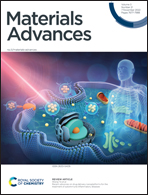Enhancing the phase change material properties by an energy-efficient one-step preparation method using organogelator–polyolefin composites†
Abstract
The synergistic combination of various sorbitol-based organogelators with polyolefins allows the preparation of porous support structures for immobilized phase change materials (PCMs). Using a PCM as a solvent for the preparation leads to dimensionally stable composite materials with extremely high loading rates and low leakage of PCMs. Detailed investigations were performed on the kind of polyolefin support and its mass fraction concentration in the PCM, the temperature-dependent softening and failure under superimposed load, the efficiency of heat transport and the retention capacity over several melting/solidification cycles in various measurement setups. In particular, paraffin wax in combination with 1,2,3-trideoxy-4,6:5,7-bis-O-[(4-propylphenyl)methylene]-nonitol (TBPMN) and ultrahigh molecular weight polyethylene (UHMWPE) showed the best results in terms of high dimensional stability, low leakage, excellent processability and competitive heat capacity. The herein-established one-step preparation method saves time and energy compared to the loading of pre-formed porous supports and improves application-related properties at the same time.



 Please wait while we load your content...
Please wait while we load your content...